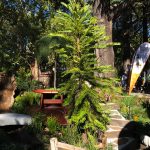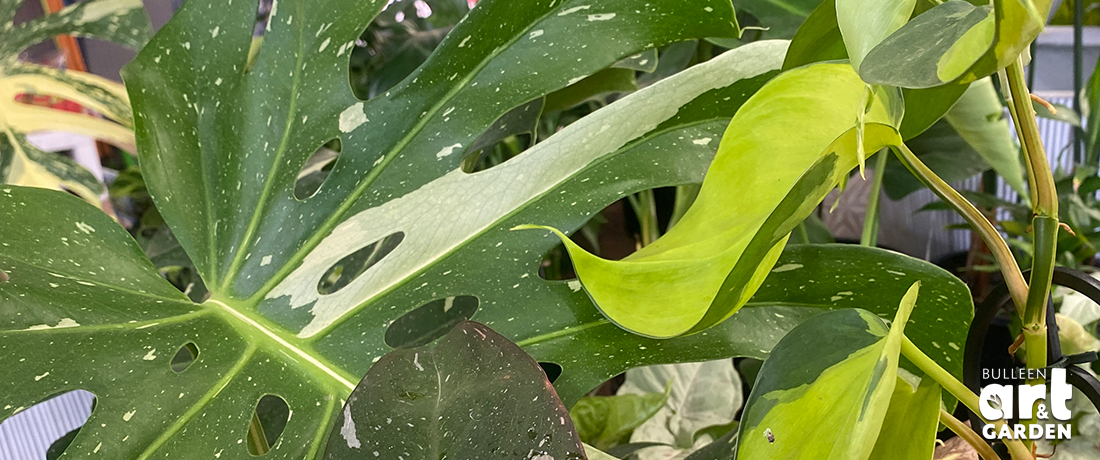
The thing to remember is all ‘indoor plants’ evolved to grow outdoors, and we are asking them to adapt to an alien, often airconditioned or heated environment. This can be done very successfully if you understand your plant’s requirements. In addition, most will benefit from an extended spell outdoors, commonly during the warmer months. This will freshen them up and keep them looking good. Ideally put them in a shady spot to acclimatize to their outside holiday, and after a month they can return thoroughly rejuvenated to their indoor life.
Watering
This is at the top of the list because more indoor plants die from overwatering than any other single factor. Nothing beats either lifting the pot (light pots are dry, heavy pots are wet) or sticking your finger into the potting mix to see how dry it is. There are several things to keep in mind:
• Large pots dry out more slowly than small ones and will generally need less frequent watering
• Actively growing plants use more water, conversely plants in a dormant phase use less. The dormant phase is their ‘rest phase’ and plants can be allowed to get significantly drier than in their growth phase. The dormant phase if often in winter, but not always.
• When you water, water thoroughly, making sure that all the potting mix gets wet and ensuring water drains out the bottom.
• It is ESSENTIAL that pots are not sitting in water. Either tip out water from saucers or raise the pot on feet or pebbles and allow water to pool below. This has the added advantage of increasing humidity, often beneficial to indoor plants.
• In winter, try to water with tepid or room temperature water.
• Consider giving you plants an occasional trip to the shower to give a chance to wash off dust, raise their humidity levels and generally have a freshen up.
• Indoor plants can have wildly different watering requirements – get to know the individual requirements of your plants.
Root rots: When plants are overwatered or poorly drained, the roots will rot away, resulting in an inability to take up water and the plant starts to droop. This often leads to a misdiagnosis of the plant needing more water, and the situation rapidly deteriorates – end result, a dead plant. If you catch the problem early, you can trim away any dead root material, repot into as small a pot as possible and trim away some of the foliage to compensate for loss of root mass. Put in a shady spot outside and cross your fingers. If you want to reuse the old pot – you will need to disinfect it with a bleach solution. Wash out pot then use a 1:100 dilution and rinse thoroughly.
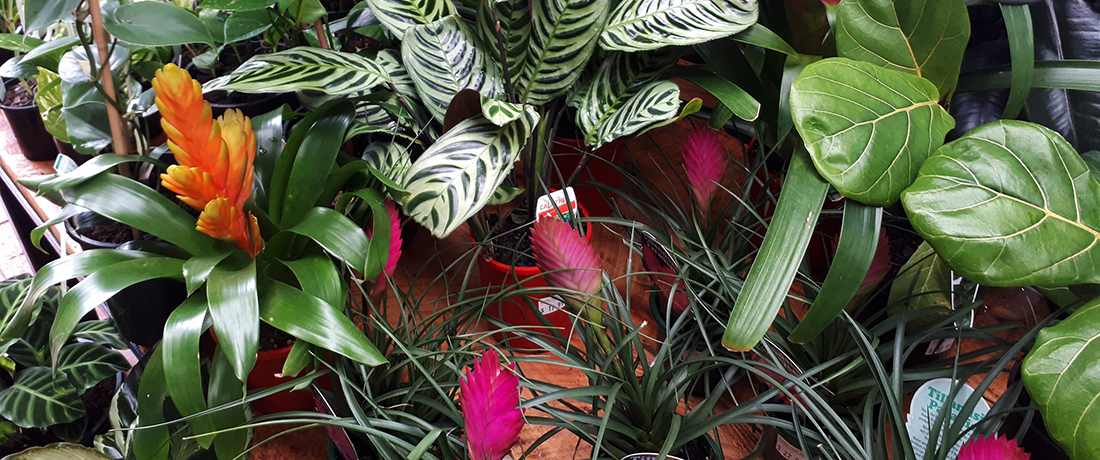
Leaves wilting despite being well watered. Leaves may turn yellow or brown and fall off.
Cause: Over watering. Roots rot due to lack of oxygen because soil is always saturated.
Solution: Only water when top of soil is dry. Check your plant’s water requirements, it may need to dry out almost completely in between watering, most plants need less water during the cooler months.
Check drain holes are not blocked or the base of the pot is not standing in water.
Leaves wilting, eventually turning brown at the tips. Older leaves turn yellow and fall off. Soil / potting mix is dry.
Cause: Under watering.
Solution: If soil is completely dry then water twice. Water until water runs out of drainage holes, leave 10 minutes and repeat until you are confident the potting mix is thoroughly re-wetted. If potting mix has completely dried out, it can shrink away from the sides of the pot, and water can run down the sides instead of re-wetting the potting mix. If this persists, dunk the entire pot in a bucket of water for 5 minutes, then let it drain.
Pale spots on leaves of hairy leafed plants.
Cause: Cold water splash on leaves.
Solution: Water carefully with very narrow tipped watering can – water the potting mix only, avoid getting water on the leaves. Use tepid or room temperature water.
Spots on leaves of succulents – especially Sanseverias.
Cause: Water splash on leaves when temperatures are cool – can lead to fungal problems.
Solution: Water carefully and water potting mix only. Give succulents a spray wash only in warmer weather. If problem is severe, remove infected leaves and spray rest of the succulent with a fungicide.
The spots wont ‘heal’ and the leaf become unblemished, all you can do is prevent it occurring again and outgrow the problem.
Position
In Melbourne the light that comes through a window can vary enormously depending on the season, what may be a perfectly suitable light level in the cooler months may scorch a plant over summer. There are few indoor plants that can cope with direct summer sun coming in through a window. Move before they get scorched to avoid unsightly damage to your plants.
Choose a plant that suits the position, it is frustrating to try and grow a plant requiring bright light in a low light conditions, it will never thrive, will almost inevitably become prone to insect/fungal problems and end up a major disappointment. Whereas an indoor plant in the appropriate conditions will thrive and give years of enjoyment.
A handy tip is to regularly spin your plants a quarter turn, this helps prevent them leaning into the light and promotes even growth.
Sudden leaf drop – commonly in a freshly brought plant, or one that has moved location.
Cause: Shock. Usually from moving from one environment to another.
Solution: Common in the ornamental figs (Ficus). If you must move them, try to reduce all other stresses, keep water, temperature, and light at ideal levels. They recover on their own anyway, it is just a messy time with leaf drop. When watering, use a weak liquid fertiliser (quarter strength) and use tepid water.
Plants are ‘stretched’: stems seem thin and weak, long stretches of stem between leaves which tend to be small and pale in colour. Plant not located in a bright position.
Cause: Not enough light.
Solution: Move the plant to a brighter spot, or open curtains/blinds and allow more light into the room. Don’t over compensate, suddenly thrusting it into the sunshine may be its death knell. You may want to prune the plant back to encourage it to bush out once in a better location.
Leaves go crispy brown at the margins, new leaves emerge smaller in size, while old leaves curl. Plant is located in a bright position.
Cause: Too much light.
Solution: Some shade lovers need to be in a lower light position. Move to a less bright spot, or use sheer curtains to filter light.
Bleached areas on leaves.
Cause: Sun scorch – commonly due to moving plant to a sunnier location.
Solution: Plants need time to adapt to new conditions. If moving a plant outside for the summer, move to a shady spot and gradually allow it to get more sun. Many will need to stay in some shade. Similarly inside, gradually move a plant that has been in a dark position into a brighter one. This helps avoid shock (see above).
Temperature and Humidity
Both heating and air-conditioning reduce humidity. Keep plants away from ducts and outlets. Ideally group indoor plants together as this helps create islands of humidity. Regular misting or a room humidifier helps, as does putting pots on feet or pebbles to ensure free drainage and allowing water to collect underneath.
A sign that humidity is too low is dry crisp edges on the leaves.
Fertilising
All potting mixes run out of fertilizer after a few months and supplementary fertilizing is required. The easiest way is to use a slow release fertilizer at the beginning of the growth period – commonly, but not always, at the start of spring. You can also use liquid fertilizer, but these do not last long and need to be used regularly over the growth period.
Rapid growth, lots of leaves, but no blooms.
Cause: Too much fertiliser, incorrect N:P:K balance.
Solution: Excess Nitrogen in the fertiliser causes lots of foliage growth at the expense of flowers. Reduce fertilising, do not fertilise when dormant. Use a fertiliser low in Nitrogen when flowers are desired. This is particularly important for orchids.
Gradual failure to thrive, leaves start to go yellow and drop – older leaves do this first. Leaves become smaller and plant growth slows right down.
Cause: Not enough fertiliser.
Solution: Plants need fertiliser when they are growing. If you apply slow release fertiliser at the start of the growing season you are usually OK, but with some plants you may need to top up with applications of liquid fertiliser. If just using liquid fertiliser, then fertilise regularly during the growing season.
Fertiliser burn: Symptoms can look similar to those for low humidity – leaf tips and edges will scorch or crisp. With indoor plants, if you are unsure how much fertiliser to apply – go for less rather than more. If they look hungry you can always add a little more later.
General Maintenance
Cut any dead or damaged leaves or fronds away, pruning as close as possible to the base of the plant.
If you want to polish or gloss the leaves, only do this with suitable plants, like Ficus elastica, Philodendrons, Monstera, aspidistras etc. Never ferns or palms. If using an oil, only ever polish one side of the leaf. Avoid using oil sprays on ferns – they generally react poorly.
If the plant is getting to large, prune back as necessary. Most plants respond well.
Repotting
The only time you ever use garden soil is when repotting water plants, for all other repotting, always use potting mix. Garden soil in a pot settles and consolidates, aeration and drainage are reduced and plants fail. Potting mix is formulated to retain its structure, allowing good aeration and drainage even after years.
Repot when plants are actively growing. Avoid hot and or windy days as this tend to rapidly dry everything out. Try to have everything ready before you start, and water the plant to be repotted the day before. Choose a pot only one size up from the existing pot. Roots will rapidly take moisture from the potting mix, if the root-ball is surrounded by a large amount of fresh potting mix, this will stay wet increasing the likelihood of root disease.
Place a few centimetres of potting mix in the base of the new pot – you want the final level of potting mix to be the same in the new pot as it was in the old pot. Carefully remove the plant from its old pot and examine the roots. This is important. If the roots are in good condition, with no girdling (wrapping around) or significant kinks, then it can go directly into the new pot. However, if there is girdling or kinking, or just a solid potbound mass, then these roots need to be loosened away from the rootball and removed (cut away). If a lot of root material is cut away, then remove a proportion of top growth to compensate. This allows the smaller root-mass to serve a smaller leaf load and the plant will recover quickly and surge ahead without a setback.
Site the plant in the new pot so the centre of the plant is roughly in the centre of the pot, if the plant was unevenly centred or tilted at an angle previously – this is your opportunity to correct that. Then pour potting mix around the sides, tamping down. Water well to settle the potting mix and remove any air pockets. You can water in with a very weak seaweed solution or plant starter solution, but it is not essential. Leave in a shady spot for a few days and it can then go back inside. Do not fertilise for a month after repotting.
Wilting and leaf loss after repotting.
Cause: Transplant shock.
Solution: Keep in semi shaded location and give optimal care until perks up.
If your plant wilts rapidly, perks up after watering, but seems to wilt too quickly after watering. it may be pot-bound. This means there is too much root in the pot and not enough potting mix to hold the water.
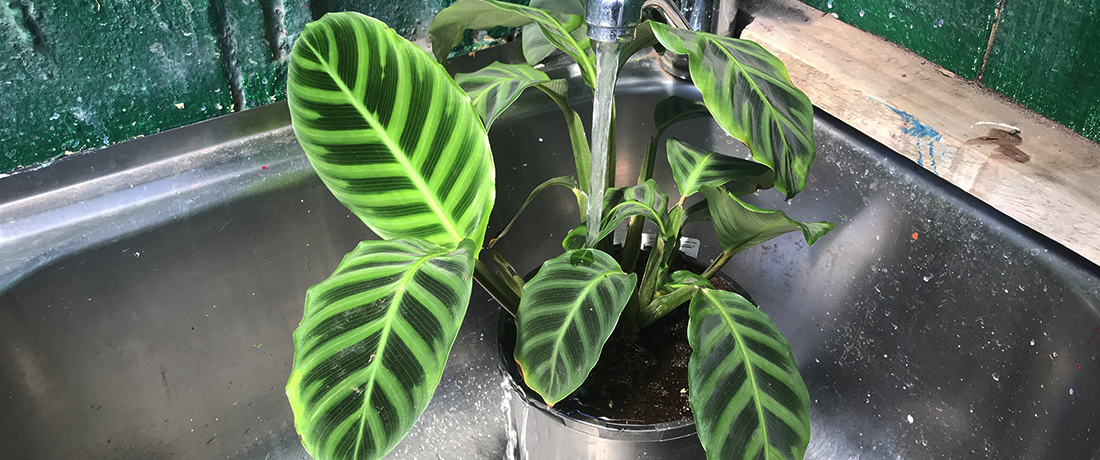
Flushing Salts from Indoor Plants
Symptoms: Drooping plants combined with leaf margins and tips browning (burning). Often accompanied by white speckles or even a white crusty build up on soil surface, visible when the potting mix is dry.
Over time, soluble salts accumulate in the potting mix of indoor plants. These salts come from fertilisers and chemicals in tap water, and cannot leach out as they would in your garden bed, so need to be periodically flushed out of your pot plant. If the leaf tips are turning brown for no apparent reason, then a build up a soluble salts may well be the culprit. You will notice a white (salty) crust build up on the pot – especially on terracotta pots, glazed or natural. Any part of the plant that touches this deposit ‘burns’. On a warm day take the pot plant outside (or if not possible, to a large sink). Using clean lukewarm or tepid water slowly pour water into the pot until it starts seeping out the drainage holes. Leave until water stops draining. Repeat twice. Empty all water from saucer or slip pot and return inside.
Pests
Be vigilant looking for pests, most commonly mealy bugs, but also mites, aphids and scale. Plants attacked by pests are often under stress, treat the pest, and try to solve the reason why the plant was stressed in the first place. A holiday outside can also help.
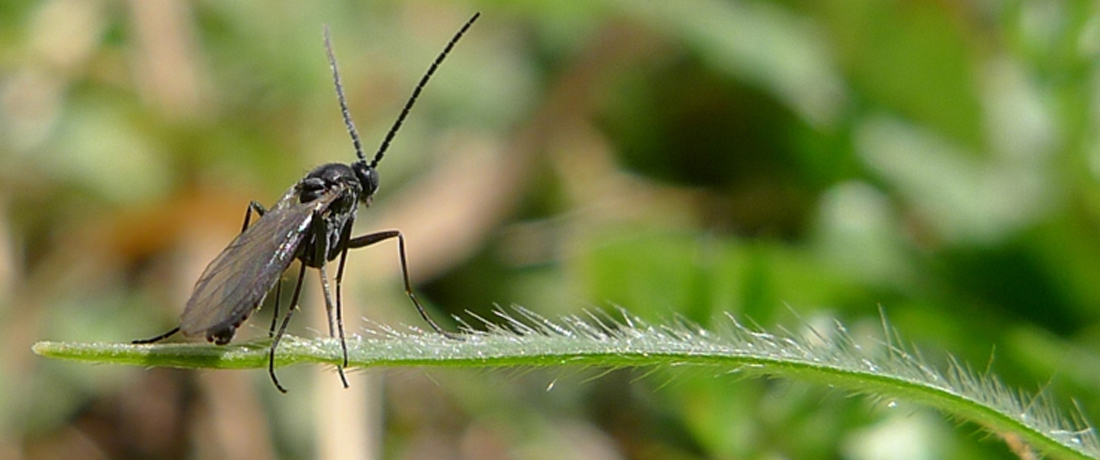
Fungal Gnats in your Indoor Plants
Fungal gnats are from the Sciaridae family of flies and are the bane of indoor plants enthusiasts. It is the larval stage of these small flying insects that create the most havoc, but their numbers can build up to such a level that the flying gnat itself creates an unpleasant nuisance in the house. Small dark bodies with long legs and a single pair of wings, these small flying insects commonly live around a week before dying en masse, usually on your sunny windowsill just before your mother in law comes to visit. The gnats lay their eggs (100-300 per female) in the soil. Once they hatch, the larvae feed for 8-14 days on root hairs, feeder roots, organic material, fungal material and even the tender lower stems of the pot plants. It is this stage that causes damage: sudden wilting, poor growth, loss of vigour, yellowing and leaf drop. After 1 to 2 weeks the larvae pupate for 7 days and then hatch into the adult flying gnats. Total life cycle is around 3-4 weeks.
Control with Gnats-a-Go-Go
Gnats-a-Go-Go is a water soluble granulated powder of a naturally occurring biological control agent (Bacillus thuringiensis subsp. Israelensis, Bti) specific to the Sciaridae family. Gnats a-Go-Go specifically targets fungus gnat larvae from first to fourth instar stage. Gnats a-Go-Go targets the in-soil stages of the life cycle, so you water the solution into the soil. A single application is generally sufficient for light infestations, or just as a preventative treatment when you bring a new plant home. Heavier infestations may need 2 to 3 treatments, 7 -10 days apart. Heavier infestations (and they can get really bad…) will need a stronger solution (more Bti to consume the greater number of larvae in the soil). You can purchase Gnats-a-Go-Go in the hardware section here at BAAG.
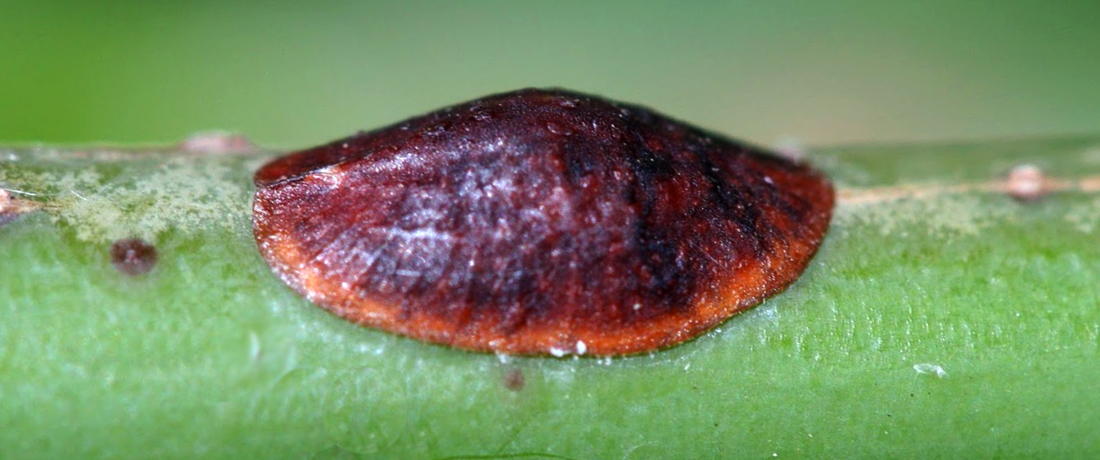
Scale on Indoor Plants
Any plant heavily infested with scale is the source of infection and needs to be isolated and treated if you are not prepared to simply bin it. A single treatment is almost never enough. Everyone wants a one shot solution – it isn’t going to happen. Treat fortnightly until you are convinced the problem is eradicated. Scale will stick to both the plant and the pot – even after you have killed them. Pick, scrape and brush them off. They like to hide in crevices and hard to get spots – be vigilant, turn the plant around and inspect from different angles and in good light. Check the pot also, scale will hide in the rim, the base and in the top layer of soil. If re-using a pot, it is essential you disinfect the pot.
Scale are covered in a protective coat, either a hard protective cover (Hard Scale) or a soft waxy covering (Soft Scale). Both types of scale tend to stay put once they find a site to feed from. They hold tightly to the plant, and may need to be brushed or picked off, even after treatment. Treat fortnightly with cotton buds dipped in rubbing alcohol and brushed over the scale, neem oil (diluted as per bottle instructions) or insecticidal soap sprayed onto the scale. These are all safe to use indoors. Be thorough and persistent. Check all the crevices, nooks and crannies. They are devious little buggers and have made hiding into an art form. If possible, trim off and bin any heavily infested leaves. Pure rubbing alcohol (isopropyl alcohol) applied with a spray bottle is very effective against scale (and mealy bug) on succulents which are easily damaged by other methods of removal/ treatment.
Scale life cycle is 2 to 3 months, and you can have all stages on the one plant. The eggs are all but invisible and the emerging nymph is also tiny and hard to see, so you may need to treat for 3 months to get all the scale. Stop treatment once you are sure all scale has been eliminated. Check the rim and the base of the pot, plus any decorative cache pots and saucers. If the scale keep coming, then remove top 2cm of soil, disinfect exposed pot, and add in fresh potting mix.
Mites on Indoor Plants
If your foliage is flecked, yellow, bleached, silvery or bronzed your plant may have mites. Profuse fine webbing is often seen with heavy infestations. Very tiny pests can generally be spotted on the undersides of the leaf. Mites are very difficult to control. If a bad infestation consider throwing out the plant. If you want to keep the plant, isolate from other plants. Try spraying the mites with natrasoap. Repeat regularly until infestation is completely eradicated. Increase humidity around plant to prevent further infestation. Another method is to fill a bucket with water at 44C and immerse the entire plant including pot for 15 minutes. Keep the water at 44C. Leave to drain. A day later do a follow up spray with natrasoap. Keep a vigilant eye out and repeat as necessary. Keep plant isolated until clear of mites. Increase humidity to prevent further infestations.
Mealy Bugs on Indoor Plants
White waxy fluffy material on plants.
Cause:
Solution: Isolate plant to avoid spreading. Check all your nearby plants. Can use natrasoap spray or if a small infestation then using a cotton top dipped in rubbing alcohol (surgical spirit, available from chemist) and dab the mealy bugs. Repeat as necessary.



